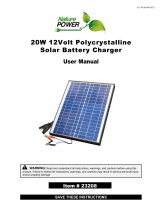
Table of Contents
1. GENERAL DESCRIPTION ........................................................................................................... 1
1.1. Solar home system .......................................................................................................... 1
1.2. MPPT solar charger ......................................................................................................... 1
1.3. Load output .................................................................................................................. 1
1.4. PAYG enabled ............................................................................................................... 1
1.5. Smart battery management ................................................................................................ 1
1.6. LCD screen .................................................................................................................. 1
1.7. Battery box ................................................................................................................... 1
2. IMPORTANT USAGE INSTRUCTIONS ............................................................................................ 2
3. INSTALLATION AND OPERATION INSTRUCTIONS ............................................................................ 3
3.1. General ....................................................................................................................... 3
3.2. Installation sequence ........................................................................................................ 3
3.3. Battery ........................................................................................................................ 3
3.3.1. General instruction ................................................................................................ 3
3.3.2. Battery box ......................................................................................................... 3
4. Solar panels ........................................................................................................................... 5
4.1. General instruction .......................................................................................................... 5
4.2. PV connection ............................................................................................................... 5
4.2.1. Model with barrel PV connectors ................................................................................ 6
4.2.2. Model with MC4 PV connectors ................................................................................. 7
4.3. Sizing examples ............................................................................................................. 7
5. Operating and storage conditions ................................................................................................ 8
6. USER INTERFACE GUIDE .......................................................................................................... 9
6.1. Keypad layout ................................................................................................................ 9
6.2. Menu map .................................................................................................................... 9
7. PAYGO FUNCTIONALLITY ........................................................................................................ 10
7.1. General ..................................................................................................................... 10
7.2. OpenPaygo token ......................................................................................................... 10
7.3. Compatible platforms ..................................................................................................... 10
7.4. Activation process ......................................................................................................... 10
8. TECHNICIAN INTERFACE GUIDE ............................................................................................... 11
8.1. Diagnostic menu ........................................................................................................... 11
8.1.1. Description ....................................................................................................... 11
8.1.2. Accessing the diagnostic menu ................................................................................ 11
8.1.3. Diagnostic menu map ........................................................................................... 11
8.1.4. View hardware and software version ......................................................................... 11
8.2. Setup menu ................................................................................................................ 11
8.2.1. Description ....................................................................................................... 11
8.2.2. Accessing the Setup menu ..................................................................................... 12
8.2.3. Setup Menu map ................................................................................................ 12
9. TROUBLESHOOTING .............................................................................................................. 14
9.1. Error message ............................................................................................................. 14
9.1.1. Alerts: ............................................................................................................. 14
9.1.2. Warnings: ........................................................................................................ 14
9.2. Device not active .......................................................................................................... 14
9.3. Low battery ................................................................................................................. 14
9.4. Solar panel level always low ............................................................................................. 15
10. SPECIFICATIONS ................................................................................................................. 16
SHS 200 MPPT
























